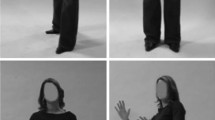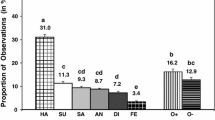Abstract
Facial expressions of fear and disgust have repeatedly been found to be less well recognized than those of other basic emotions by children. We undertook two studies in which we investigated the recognition and visual discrimination of these expressions in school-age children. In Study 1, children (5, 6, 9, and 10 years of age) were shown pairs of facial expressions, and asked to tell which one depicted a target emotion. The results indicated that accuracy in 9- and 10-year-olds was higher than in 5- and 6-year-olds for three contrasts: disgust–anger, fear–surprise, and fear–sadness. Younger children had more difficulty recognizing disgust when it was presented along with anger, and in recognizing fear when it was presented along with surprise. In Study 2, children (5, 6, 9, and 10 years of age) were shown a target expression along with two other expressions, and were asked to point to the expression that was the most similar to the target. Contrary to our expectations, even 5- and 6-year-olds were very accurate in discriminating fear and disgust from the other emotions, suggesting that visual perception was not the main limiting factor for the recognition of these emotions in school-age children.


Similar content being viewed by others
Notes
The data were also submitted to arcsine transformations prior to ANOVAs in the rest of this article.
It was not possible to perform an Age x Contrast ANOVA because the variance was null for the contrast fear-anger in the older age group.
References
Bornstein, M. H., & Arterberry, M. E. (2003). Recognition, discrimination and categorization of smiling by five-month-old infants. Developmental Science, 6, 585–599.
Boyatzis, C. J., Chazan, E., & Ting, C. Z. (1993). Preschool children’s decoding of facial emotions. The Journal of Genetic Psychology, 154, 375–382.
Bullock, M., & Russell, J. A. (1984). Preschool children’s interpretation of facial expressions of emotion. International Journal of Behavioral Development, 7, 193–214.
Bullock, M., & Russell, J. A. (1985). Further evidence on preschoolers’ interpretation of facial expressions. International Journal of Behavioral Development, 8, 15–38.
Camras, L. (1980). Children’s understanding of facial expressions used during conflict encounters. Child Development, 51, 879–885.
Camras, L., & Allison, K. (1985). Children’s understanding of emotional facial expressions and verbal labels. Journal of Nonverbal Behavior, 9, 84–94.
Ekman, P. (1993). Facial expression and emotion. American Psychologist, 48, 384–392.
Ekman, P. (2003). Emotions revealed: Recognizing faces and feelings to improve communication and emotional life. New York: Times Books.
Ekman, P., & Friesen, W. V. (1978a). Facial action coding system: A technique for the measurement of facial action. Palo Alto, CA: Consulting Psychologists Press.
Ekman, P., & Friesen, W. V. (1978b). Facial action coding system: Part two. Palo Alto, CA: Consulting Psychologists Press.
Gao, X., & Maurer, D. (2009). Influence of intensity on children’s sensitivity to happy, sad, and fearful facial expressions. Journal of Experimental Child Psychology, 102, 503–521.
Gibson, E. J., & Spelke, E. S. (1983). The development of perception. In J. H. Flavell & E. M. Markman (Eds.), Handbook of child psychology: Vol. 3. Cognitive development (pp. 1–76). New York: Wiley.
Gosselin, P. (1995). Le développement de la reconnaissance des expressions faciales des émotions chez l’enfant [The development of the recognition of facial expressions of emotion in children]. Canadian Journal of Behavioral Sciences, 27, 107–119.
Gosselin, P., & Kirouac, G. (1995). Le décodage de prototypes émotionnels faciaux [Decoding facial emotional prototypes]. Canadian Journal of Experimental Psychology, 49, 313–329.
Gosselin, P., & Larocque, C. (2000). Facial morphology and children’s categorization of facial expressions of emotions: A comparison between Asian and Caucasian faces. The Journal of Genetic Psychology, 161, 346–358.
Gosselin, P., Roberge, P., & Lavallée, M. C. (1995). Le développement de la reconnaissance des expressions faciales émotionnelles du répertoire humain [The development of the recognition of facial emotional expressions comprised in the human repertoire]. Enfance, 4, 379–396.
Gosselin, P., & Simard, J. (1999). Children’s knowledge of facial expressions of emotions: Distinguishing fear and surprise. The Journal of Genetic Psychology, 160, 181–193.
Harrigan, J. A. (1984). The effects of task order on children’s identification of facial expressions. Motivation and Emotion, 8, 157–169.
Izard, C. E. (1991). The psychology of emotion. New York: Plenum.
Johnstone, T., & Scherer, K. R. (2000). Vocal communication of emotion. In M. Lewis & J. M. Haviland-Jones (Eds.), Handbook of emotions (pp. 220–235). New York: The Guildford Press.
Labarbera, J. D., Izard, C. E., Vietze, P., & Parisi, S. A. (1976). Four- and six-month-old infants’ visual responses to joy, anger, and neutral expressions. Child Development, 47, 535–538.
Markham, R., & Adams, K. (1992). The effect of type of task on children’s identification of facial expressions. Journal of Nonverbal Behavior, 16, 21–39.
Matsumoto, D., & Ekman, P. (1989). Japanese and Caucasian facial expressions of emotion (JACFEE). Available from David Matsumoto, Department of Psychology, San Francisco State University, 1600 Holloway, San Francisco, CA, 94132.
Nelson, C. A. (1987). The recognition of facial expressions in the first two years of life: Mechanisms of development. Child Development, 58, 889–909.
Nelson, C. A., & Dolgin, K. (1985). The generalized discrimination of facial expressions by seven-month-old infants. Child Development, 56, 58–61.
Russell, J. A., & Bullock, M. (1986). On the dimensions preschoolers use to interpret facial expressions of emotion. Developmental Psychology, 22, 97–102.
Russell, J. A., & Widen, S. C. (2002). A label superiority effect in children’s categorization of facial expressions. Social Development, 11, 30–52.
Small, M. Y. (1990). Cognitive development. New York: Harcourt Brace Jovanovich.
Striano, T., Brennan, P. A., & Vanman, E. J. (2002). Maternal depressive symptoms and 6-month-old infants’sensitivity to facial expressions. Infancy, 3, 115–126.
Tremblay, C., Kirouac, G., & Doré, F. (1987). The recognition of adults’ and children’s facial expressions of emotions. The Journal of Psychology, 12, 341–350.
Vicari, S., Snitzer Reilly, J., Pasqualetti, P., Vizzotto, A., & Caltagirone, C. (2000). Recognition of facial expressions of emotions in school-age children: The intersection of perceptual and semantic categories. Acta Paediatrica, 89, 836–845.
Vurpillot, E., Castelo, R., & Renard, C. (1975). Extent of visual exploration and number of elements present around the stimulus in a perceptual differentiation task. Année Psychologique, 75, 362–363.
Wagner, H. L. (1993). On measuring performance in category judgment studies of nonverbal behavior. Journal of Nonverbal Behavior, 17, 3–28.
Widen, S. C., & Russell, J. A. (2003). A closer look at preschoolers’ freely produced labels for facial expressions. Developmental Psychology, 39, 114–128.
Widen, S. C., & Russell, J. A. (2004). The relative power of an emotion’s facial expression, label, and behavioral consequence to evoque preschoolers’ knowledge of its cause. Cognitive Development, 19, 111–125.
Widen, S. C., & Russell, J. A. (2008). Children acquire emotion categories gradually. Cognitive Development, 23, 291–312.
Wiggers, M. (1982). Judgments of facial expressions of emotion predicted from facial behavior. Journal of Nonverbal Behavior, 7, 101–115.
Author information
Authors and Affiliations
Corresponding author
Rights and permissions
About this article
Cite this article
Gagnon, M., Gosselin, P., Hudon-ven der Buhs, I. et al. Children’s Recognition and Discrimination of Fear and Disgust Facial Expressions. J Nonverbal Behav 34, 27–42 (2010). https://doi.org/10.1007/s10919-009-0076-z
Received:
Accepted:
Published:
Issue Date:
DOI: https://doi.org/10.1007/s10919-009-0076-z




